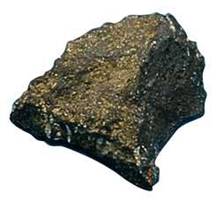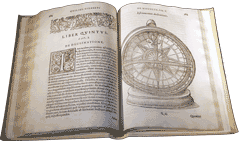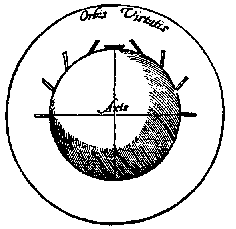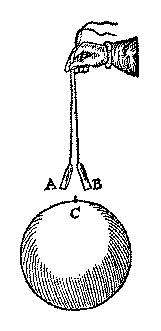Handout #15: William Gilbert and Magnetism
 The ancient Greeks noted magnetism in the mineral magnetite or lodestone. In fact, as with so many other words (including “electricity”) magnetism gets its name from the Greeks, who had named an area that happened to contain abundant amounts of lodestone “Magnesia”.
The ancient Greeks noted magnetism in the mineral magnetite or lodestone. In fact, as with so many other words (including “electricity”) magnetism gets its name from the Greeks, who had named an area that happened to contain abundant amounts of lodestone “Magnesia”.
In the Greek mythology, a shepherd boy named Magnes thrust his iron staff into a hole containing magnetite and found to his dismay that he was unable to remove it.
Socrates and Plato also noted magnetism in some of their writings. It is also said that 2,300 years ago, Ptolemy Philadelphos had a temple at Alexandria made from magnetite so he could suspend a statue in mid-air. His experiment didn't work.
The next time you go to the beach, you can find magnetite if you take a magnet and drop it in the sand. What sticks to the magnet is usually magnetite.
Shen-Kua, a Chinese mathematician and instrument maker, was the first person to mention the use of a magnetized needle (a compass) for use in navigation. He lived from 1030 to 1093. It took Europe a few hundred more years to recognize that magnets could help you find your way at sea!

 William Gilbert, who lived from 1544-1603, wrote a book entitled “De Magnete” which is recognized as the world’s first published work on the phenomenon of electricity and magnetism, and one of the greatest works in the history of scientific discovery. Gilbert himself has been called "The Galileo of Magnetism" and "The Father of the Scientific Method of Investigation. His book influenced Kepler, Bacon, Boyle, Newton, and in particular, Galileo, who used his theories to support his own proof of the correctness of Copernicus in cosmology.
William Gilbert, who lived from 1544-1603, wrote a book entitled “De Magnete” which is recognized as the world’s first published work on the phenomenon of electricity and magnetism, and one of the greatest works in the history of scientific discovery. Gilbert himself has been called "The Galileo of Magnetism" and "The Father of the Scientific Method of Investigation. His book influenced Kepler, Bacon, Boyle, Newton, and in particular, Galileo, who used his theories to support his own proof of the correctness of Copernicus in cosmology.
Gilbert carried out many experiments, but the most famous one was his explanation, why the compass pointed north. He shaped a big lodestone into a sphere. Since it was meant be a model of the Earth, he named it "Terrella," meaning, "little Earth." (See diagram below.)

Over the surface of the terrella he moved a magnetic compass. More accurately--since the compass had to stay horizontal--he moved the terrella, placing the compass next to various points on it. When the compass was level with the surface of the terrella, the needle always pointed to the magnetic north pole of the terrella.
 The picture here shows what happened when the compass was perpendicular to the terrella--the poles are on the left and right, the equator on top, and the needle in general slants down, just the way Robert Norman observed. At the poles, it points straight down, on the equator it is horizontal. This experiment convinced him that the directionality of the compass was caused by the Earth itself being a great magnet. Supposedly, he demonstrated his terrella to Queen Elizabeth--at least, a painting of such a demonstration exists.
The picture here shows what happened when the compass was perpendicular to the terrella--the poles are on the left and right, the equator on top, and the needle in general slants down, just the way Robert Norman observed. At the poles, it points straight down, on the equator it is horizontal. This experiment convinced him that the directionality of the compass was caused by the Earth itself being a great magnet. Supposedly, he demonstrated his terrella to Queen Elizabeth--at least, a painting of such a demonstration exists.
Gilbert obviously knew that certain types of metal needles were attracted to magnets and could even be made to exhibit magnetic properties themselves. Why are pins and nails attracted to magnets? Gilbert argued that the influence of the magnet turned them into temporary magnets, too. Here is how he demonstrated it--by hanging two bars of iron above the pole of a terrella, and noting that they repelled each other (see diagram at left).
Home